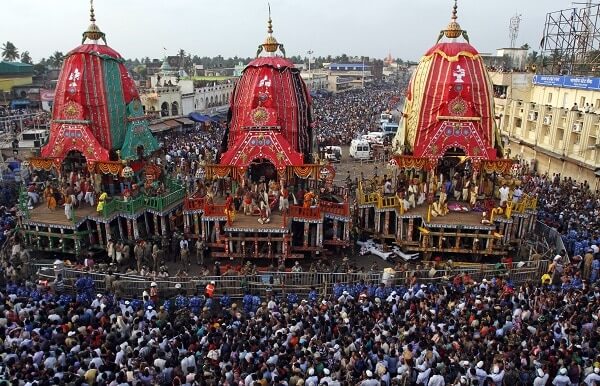On the eve of Rath Yatra of Lord Jagannath, renowned sand artist Sudarshan Pattnaik has created 125 sand chariots and a sand sculpture of Lord Jagannath on Puri beach in Odisha.
Pattnaik, along with students of his sand art institute, took about 14 hours to complete these sculptures.
Pattnaik already holds the record of creating 100 sand chariots, and is now attempting to create another record for the Limca Book of Records with this new feat.
Pattnaik said that sand art is believed to have originated during the Rath Yatra in the 16th century. It was initiated by Balaram Das, a staunch devotee of Jagannath and a famous poet who was once humiliated by servitors and not allowed to pull the chariot during Rath Yatra. He then went to the beach and sculpted chariots on the sand.
Meanwhile, thousands of devotees have started thronging the pilgrim town Puri as the stage is all set for the nine-day Rath Yatra beginning 1 July. After a gap of two years owing to the Covid pandemic, devotees are allowed to witness the biggest festival of Odisha this year.
The Singha Dwar (Lion’s Gate) in front of the Jagannath temple was soaked in religious fervour on 30 June as servitors and devotees pulled the three grand chariots from the Ratha Khala (where the chariots were being made) to the main gate of the shrine amid the beating of cymbals and blowing of conches.
The three chariots are now parked in front of the Singha Dwar facing East towards Gundicha temple. They have been kept ready and will be pulled by thousands of devotees on the afternoon of 1 July.
READ ALSO: Vaishno Devi pilgrimage: Ropeway announced

Why we celebrate Rath Yatra: The journey of life
By Usha Arvind
A metaphor for the relentless and unstoppable force of good over evil, crushing anything along the way, ‘juggernaut’ is a widely accepted English term. Derived from the Indian term Jagannath (Lord of the Universe), an avatar of Vishnu – the Creator and Protector, it celebrates the blinding power of devotion and self surrender in the annual ritual of the Rath Yatra, Chariot Festival.
The Rath Yatra is an event that is gaining popularity around the world thanks to ISKCON. Massive chariots, carrying the figures of Lord Krishna, one of Hinduism’s most cherished gods, and his siblings Balaram and Subhadra, are drawn through the streets of the city in Puri, in India’s Orissa state.
On the day of the ‘journey’, thousands of pilgrims pull the three, 45-foot-high chariots – the yellow coloured Nandighosa, blue coloured Deviratha and red Taladwaja, on the Badadanda in a procession to Gundicha Ghar (the Lord’s birthplace). Ahead of this, the king of Puri sweeps the chariots with scented water and golden broom.

Celebrated for thousands of years, the Rath Yatra is a symbolic journey, a pilgrimage accompanied by numerous rituals and chanting, where Hindus seek divine intervention to steer the chariots of their mundane lives through the vicissitudes of Samsara.
Atmanam rathinam viddhi shareeram rathameva tu,
Buddhim tu sarathim viddhi manaha pragrahameva tu.
Indriyani hayanyahur vishayansteshu gocharan,
(Katha Upanishad)
The person whose Sarathi (intellect) is wise and whose mind fully controls the senses, can traverse Samsara (yatra of life) to reach the desired goal – the Lord’s abode.
The ultimate essence of the chariot imagery is that the Jiva should unwarrantedly surrender to the supreme Sarathi.
Australia has been hosting the Yatra since 1974. The first event was held in Melbourne, presided over by Srila Prabhupada, the former head of ISKCON. Ratha Yatra has been held in Sydney, Perth, Wollongong and Newcastle, since then.
READ ALSO: Amarnath yatra 2022: First prayers at holy cave shrine





